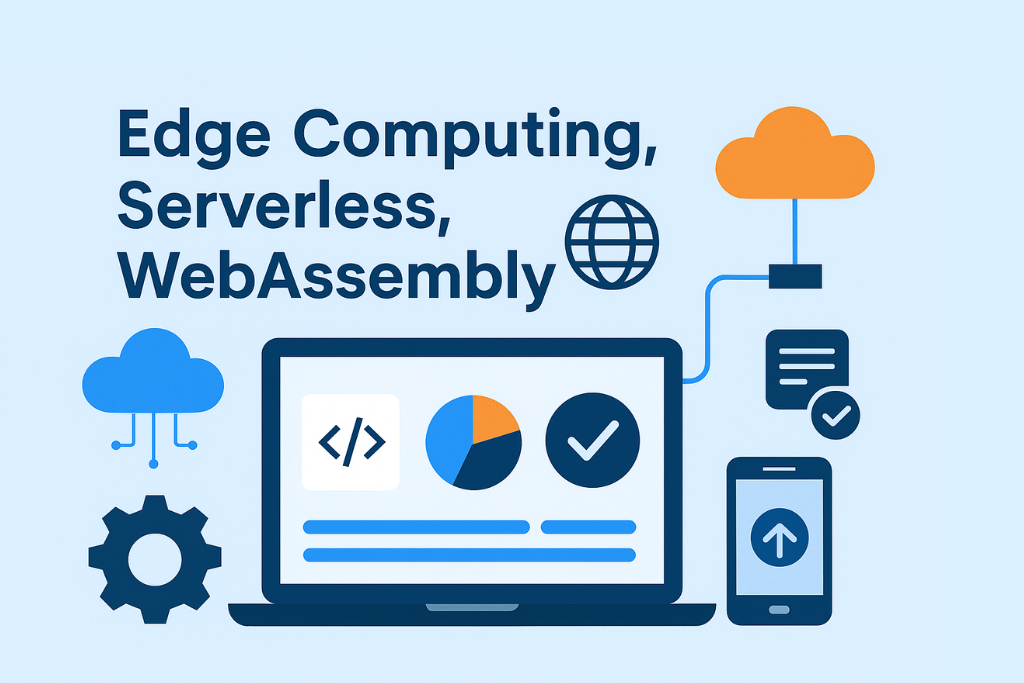Edge Computing, Serverless Architecture & WebAssembly: What Web Developers Should Know

The world of web development is evolving faster than ever. Traditional hosting and monolithic applications are no longer enough to meet the demands of modern users who expect speed, scalability, and seamless digital experiences. This shift has brought edge computing, serverless architecture, and WebAssembly into the spotlight.
These three technologies are redefining how developers build, deploy, and optimize applications. Together, they allow teams to create powerful, secure, and highly responsive systems without relying on heavy infrastructure or long development cycles. In this guide, we’ll explore what edge computing, serverless architecture, and WebAssembly mean for web developers, their benefits, challenges, and why they are central to the future of web performance and SEO.
What is Edge Computing?
Edge computing is the practice of processing data closer to the source (user devices, IoT systems, or local servers) rather than relying solely on centralized cloud servers.
Benefits of Edge Computing for Developers
-
Faster Performance: By reducing latency, websites and apps load faster, improving user experience.
-
Scalability: Handle large volumes of data locally before pushing only essential information to the cloud.
-
Security: Sensitive data can be processed closer to the device, reducing exposure risks.
-
SEO Impact: Search engines like Google prioritize fast-loading sites, and edge computing directly boosts page speed SEO ranking factors.
For developers, edge computing means you can offload computation-heavy tasks to local servers while maintaining a lighter cloud footprint.
What is Serverless Architecture?
Serverless architecture doesn’t mean “no servers.” Instead, it means developers don’t need to manage servers. Cloud providers like AWS Lambda, Google Cloud Functions, and Azure Functions automatically scale resources based on demand.
Benefits of Serverless Architecture
-
Cost-Efficiency: Pay only for the execution time, not idle server capacity.
-
Faster Deployment: Developers can focus on writing code while infrastructure is managed by providers.
-
Automatic Scaling: Apps handle sudden traffic spikes without downtime.
-
Better UX & SEO: Downtime and slow performance can hurt rankings—serverless helps eliminate both.
For web developers, this model removes the hassle of backend management, letting teams focus on building lean, user-centric applications.
What is WebAssembly?
WebAssembly (often abbreviated as Wasm) is a binary instruction format that enables high-performance applications to run in browsers. It allows developers to use languages like C, C++, and Rust on the web, providing near-native performance.
Benefits of WebAssembly for Developers
-
High Performance: Execute complex applications (like games, AI, or data visualization) directly in browsers.
-
Cross-Platform Support: Works seamlessly across devices and operating systems.
-
Improved UX: Smooth, fast, and responsive applications mean longer user engagement.
-
SEO-Friendly: While WebAssembly isn’t directly crawlable, faster load times and improved interactivity help boost rankings.
WebAssembly empowers developers to push the boundaries of what’s possible on the web.
Edge Computing, Serverless Architecture & WebAssembly: The Perfect Trio
When combined, these three technologies offer unmatched efficiency and flexibility.
-
Edge Computing reduces latency by moving processes closer to users.
-
Serverless Architecture ensures apps scale dynamically without developers worrying about infrastructure.
-
WebAssembly provides near-native performance for browser applications.
Together, they allow developers to create web experiences that are faster, more reliable, and SEO-optimized.
Why Developers Should Care About Edge Computing Serverless and WebAssembly
1. Speed is an SEO Ranking Factor
Google’s Core Web Vitals emphasize loading speed, interactivity, and visual stability. Edge computing and serverless systems ensure websites are fast, while WebAssembly powers advanced features without performance drops.
2. Scalability Without Complexity
Developers don’t need to manage physical or virtual servers. With serverless platforms handling scaling, apps remain stable even during viral traffic spikes.
3. Better User Experience (UX)
Users leave if a website takes more than 3 seconds to load. With edge computing, serverless functions, and WebAssembly, developers deliver instant, engaging experiences.
4. Cost-Effective Development
Serverless systems reduce infrastructure costs. Combined with WebAssembly’s performance boost, development cycles shorten while efficiency increases.
Practical Use Cases for Developers
Edge Computing Use Cases
-
Content Delivery Networks (CDNs) like Cloudflare and Akamai delivering cached content globally.
-
Real-time IoT analytics for connected devices.
-
Localized data processing for security and compliance.
Serverless Architecture Use Cases
-
On-demand image resizing and file processing.
-
Chatbots and voice assistants that scale with usage.
-
Event-driven automation such as notifications, billing, or log tracking.
WebAssembly Use Cases
-
Running high-performance games in browsers.
-
Data-heavy tasks like video editing or 3D rendering online.
-
Bringing legacy applications to the web without losing speed.
Challenges Developers Face
Edge Computing Challenges
-
Security at multiple edge nodes.
-
Managing distributed infrastructure.
-
Debugging complexity.
Serverless Architecture Challenges
-
Cold starts (delays when functions run after being idle).
-
Vendor lock-in with specific cloud providers.
-
Debugging limitations compared to traditional systems.
WebAssembly Challenges
-
Limited access to browser APIs.
-
Debugging complexity for non-JS developers.
-
SEO considerations since Wasm code isn’t directly crawlable.
Future of Edge Computing, Serverless & WebAssembly
The future of web development lies in faster, leaner, and smarter applications.
-
Edge computing will become standard for content-heavy apps.
-
Serverless functions will dominate backend systems, making infrastructure nearly invisible.
-
WebAssembly will revolutionize what’s possible in-browser, from machine learning to real-time 3D.
For developers, mastering these technologies means staying ahead in performance, SEO, and scalability.
The digital era demands speed, scalability, and seamless experiences. Edge computing, serverless architecture, and WebAssembly aren’t just buzzwords—they’re the building blocks of the next generation of web development.
For web developers, embracing these technologies ensures not only better performance and user experience but also stronger SEO rankings and brand credibility.
As businesses and users expect faster, smarter, and more reliable web solutions, developers who master this trio will lead the future of digital innovation.
